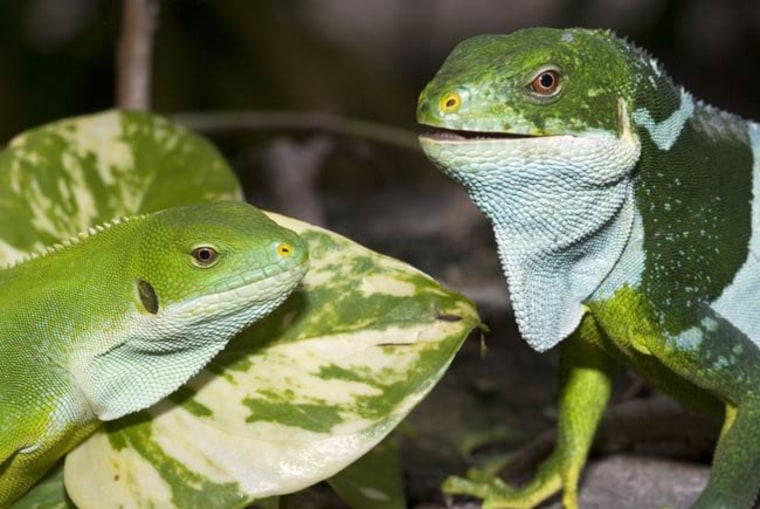A new iguana has been discovered in the central regions of Fiji.
The species, , joins only two other living Pacific iguana species, one of which is critically endangered. The scientific name bulabula is a doubling of bula, the Fijian word for hello.
Pacific generally are endangered. Two species were eaten to extinction after people arrived nearly 3,000 years ago. The three living Brachylophus iguana species face threats from loss and alteration of their habitat, as well as from feral cats, mongooses and goats that eat iguanas or their food source.
"Our new understanding of the species diversity in this group is a first step in identifying conservation targets," said Robert Fisher, a research zoologist at the U.S. Geological Survey in San Diego, and coauthor of a study on the new iguana with scientists from the Australian National University and Macquarie University in Australia.
Endangered species
Among the iguanas studied by Fisher, with only one exception, on each of the 13 islands where living iguanas were sampled, the researchers found at least one distinct iguana genetic line that was not seen elsewhere.
For instance, the Fiji crested iguana, Brachylophus vitiensis, is gone from many islands it once occupied and is now listed as on the Red List of the International Union for Conservation of Nature. The IUCN is the largest global environmental network.
The new study indicates that the other previously-identified Pacific iguana species, Brachyophus fasciatus, is probably critically endangered also, Fisher said.
Traveling iguanas
The mystery of how iguanas at the Pacific islands has long puzzled biologists and geographers. The reptiles' closest relatives are found nearly 5,000 miles away across the ocean in the New World.
The Fijian iguanas are well-known for their beauty and also their unusual occurrence in the middle of the Pacific Ocean because all of their closest relatives are in the Americas, said Scott Keogh, an associate professor at the Australian National University in Canberra, Australia, and lead author of the study.
The highest islands of Fiji have been continuously above sea level for at least the last 16 million years, and the current study's findings suggest that the Pacific iguanas, both extinct and living, were likely on the islands much of that time. Ancestors of the Pacific iguanas may have arrived up to 13 million years ago after making a 5,000 mile rafting trip from the New World.
Invasives and climate change
Efforts to describe the diversity of Pacific iguanas is important in setting biodiversity targets for the Pacific Basin, Fisher said.
"This island basin is currently under attack by a number of invasive species such as the brown tree snake, various rat species and the coqui frog, which tend to reduce biodiversity," said Fisher. "Climate change may reduce coastal habitats and alter coastlines in the Pacific, further putting biodiversity at risk. A more accurate understanding of the patterns and processes that impact diversity in these unique island groups will help land managers set appropriate goals for conservation of these resources."
The new discovery is detailed a recent special edition of the journal Philosophical Transactions of the Royal Society B that pays tribute to Charles Darwin's contribution to the Pacific region. The other coauthors of the study are Danielle Edwards at the Australian National University, and Peter Harlow at Macquarie University in Australia.
